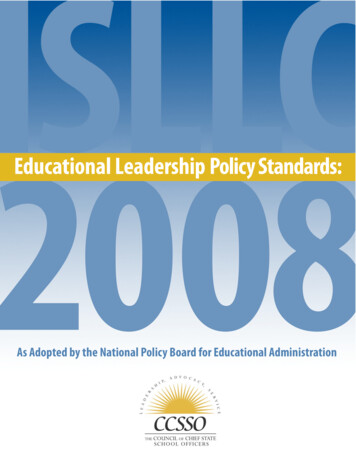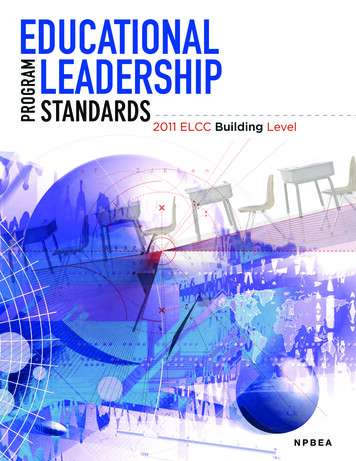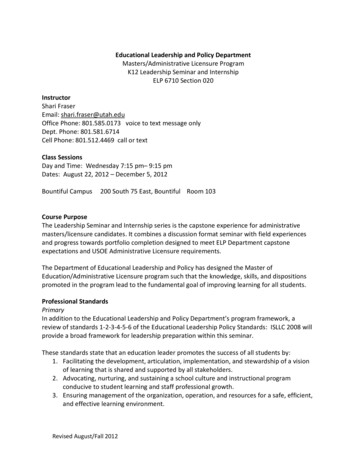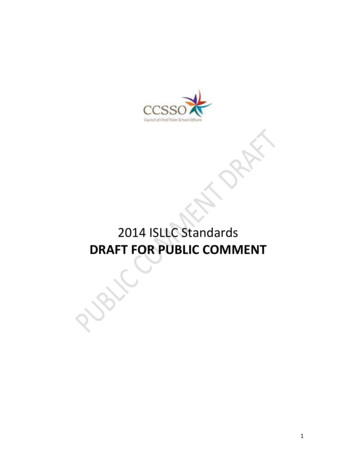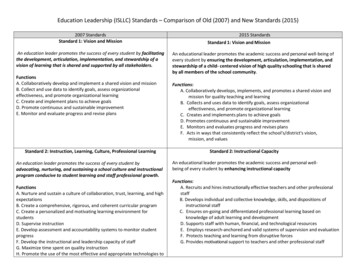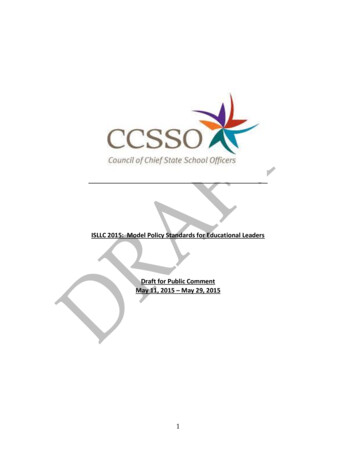
Transcription
ISLLC 2015: Model Policy Standards for Educational LeadersDraft for Public CommentMay 11, 2015 – May 29, 20151
Introduction .3Policy Standards: Defining the Core Practices of Transformational Leaders .4Developing the Policy Standards .5Using the Standards .62015 ISLLC Standards: A Transformational Vision of Education Leadership .7Foundations of Transformational Leadership.8A Focus on Continuous Improvement . 10ISLLC 2015 Standards . 13Appendix: Glossary of Terms . 20Acknowledgements . 21Selected Bibliography . 222
IntroductionA historic shift is happening in the field of educational leadership. Policy makers, parentsand other constituents of public schools are increasingly holding education leadersaccountable for the academic success and personal well-being of every student. No longeris it enough to develop and implement policies, manage finances, maintain a spotlessbuilding and keep the busses running on time. Education leaders must also provideconclusive evidence that the children in their care are being better prepared for college,careers and life.School principals and district superintendents are not the only ones feeling the pressureof increased expectations. Today, education leadership is a collaborative effortdistributed among a number of professionals in schools and districts. School-level leadersinclude administrators, teacher leaders and department chairs. District leaders holdpositions such as superintendents, curriculum supervisors, talent managementspecialists, assessment directors, principal supervisors and professional learningproviders. Their titles may vary, but they are all charged with the same fundamentalchallenge: Transform public schools to increase student learning and achievement.Realizing better outcomes for students is hard work. Clear and consistent standards canguide that herculean effort. The refreshed ISLLC 2015 standards clarify the mostimportant work and responsibilities of learning-focused leaders operating in today’seducation context. Grounded in both research and effective practice, these standardsprovide a framework for state departments of education and districts alike to understandhow to best prepare, support and evaluate education leaders in their efforts to help everychild reach his or her fullest potential. By adopting or adapting these standards, statesand districts can establish policies and practices that will guide the career trajectories ofleaders throughout the public education system. The standards can also inform howschools and districts recruit and cultivate leaders who can build teams that share anddistribute the responsibilities required for high levels of student learning andachievement to occur.In Learning from Leadership, a landmark 2010 report by The Wallace Foundation that linkseffective school leadership to student achievement, authors Karen Seashore Louis,Kenneth Leithwood, Kyla Wahlstrom and Stephen Anderson accurately describe the workof transformational education leaders today:Leadership is all about organizational improvement; more specifically, it isabout establishing agreed-upon and worthwhile directions for theorganization in question, and doing whatever it takes to prod and supportpeople to move in those directions. Our general definition of leadershiphighlights these points: It is about direction and influence. Stability is thegoal of what is often called management. Improvement is the goal ofleadership.3
A transformed public education system requires a new vision of leadership, one that goesbeyond management and asks leaders to maintain a laser-like focus on student learningas they pursue a course of continuous improvement in their day-to-day work. ISLLC 2015outlines such a vision of leadership. These standards can ensure that education leadersare equipped with the vital knowledge, skills, and dispositions to transform our schoolsinto places that empower students to take ownership of their learning, emphasize thelearning of content and the application of knowledge to real-world problems, and valuethe differences each student brings to the classroom. Our public education system--andthe millions of children it serves--are counting on them to take on this significantchallenge.Policy Standards: Defining the Core Practices of Transformational LeadersOur understanding of effective educational leadership has grown significantly since thefirst ISLLC standards were released in 1996. ISLLC 2015 has been recast to betterincorporate the expanding body of research and best practices from the field. Thestandards are designed as a broad set of national guidelines that states may adopt,adapt or use as a model for developing their own standards. While research on the useand impact of the ISLLC standards is not as robust as we would like, it is fair to say thatthey have blanketed the profession of education leadership. In particular, they currentlyprovide the policy scaffolding for school leadership in 45 states and the District ofColumbia.Standards ensure that everyone involved in the development of effective leadershippractice--state policy makers, preparation programs, professional associations,professional learning providers, and individual practitioners--shares a clearunderstanding of what’s expected of education leaders. The standards can then serve asthe foundation for an aligned system that prepares, licenses, develops, supports andevaluates them effectively.Indeed, state departments of education are already deeply engaged in policy worksurrounding the preparation, support and evaluation of education leaders. For example,the majority of states now have processes in place to guide school leaders in annualcycles of student assessment, analyzing organizational effectiveness and improvementplanning. One key objective of ISLLC 2015 is to challenge states, accrediting bodies,preparation programs, districts and individual practitioners to heed the standards’framework in answering several essential questions about education leadership: What knowledge, skills, dispositions and experiences do aspiring educationleaders need to lead effective student- and results-focused schools?How does a district or school evaluate the knowledge, skills and dispositions ofleaders to improve student learning and achievement?4
How does a state or district develop, implement, and evaluate coaching andmentoring of leaders?How does a state or district develop, support and assess continued professionallearning and growth of education leaders?How does a state, district or school evaluate the knowledge, skills anddispositions of leaders in meeting expectations?How do individual leaders develop their professional knowledge, skills anddispositions?How do education leaders recruit, grow, and support leadership teams andteacher leaders to share the important work that needs to occur in schools anddistricts to enhance student learning and achievement?Developing the Policy StandardsUltimately, the quality of a set of standards depends upon the input on which it isbased. The standards flow from an 18-month revision process that took acomprehensive look at the new education leadership landscape. The work included arigorous review of empirical research about effective leadership and leadership in highperforming schools and systems. The bibliography lists a small but important sample ofthe extensive research base used to ground the standards. The full research base hasbeen compiled into an online database at [INSERT URL HERE].In addition to reviewing the research, the process also sought input from practitioners inthe field. Focus groups and surveys captured the ideas and opinions of more than 1,000practitioners at schools, districts and preparation programs around the country whoshared insights about the role of the principal, superintendent and other educationleaders. Their opinions helped to identify gaps between the real, day-to-day work ofeducation leaders and the 2008 standards and functions.The research review and practitioner feedback also identified key practices oftransformational leaders, which informed the 2015 standards. These key practices are: Promoting a strong, shared student-centered vision and being a moral compass inproviding directionUsing data to guide their work, while attending to equity issues and the individualneeds of every studentBuilding individual leader and teacher capacity and developing the collectivecapacity of the staff to improve teaching, learning and leadership in the schoolFostering a collaborative work environment and developing productive relationshipswith staff, particularly in regards to implementing local, state and national reformsPromoting on-going improvement, while looking to the future direction ofeducation and the school5
Finally, the standards were informed by core education values such as equity and ethicalconduct that are essential to leadership practice but do not lend themselves as easily toempirical research.Using the StandardsISLLC 2015 will come to life as they guide the development and implementation ofpolicies and practices at the state and local level that ensure education leaders have thespecific skills, knowledge and dispositions to reach their fullest potential. To make thiswork most effective, states and districts should first bring all affected stakeholders tothe table to discuss the standards and assess how best to adopt or adapt them giventheir local context. Seeking input from all of the stakeholders builds buy-in. It helpsensure that they understand the qualities desired in education leaders and that they willsupport the policies and practices established as a result.State policy makers can use the standards to strengthen all aspects of an alignedsystem, from preparation and licensure through ongoing professional learning andevaluation. ISLLC 2015 will help shape the National Educational Leadership Preparation(NELP) standards, formerly the Educational Leadership Constituent Council (ELCC)standards, which will guide the preparation of aspiring education leaders. In addition,NELP 2015 will inform the process through which preparation programs seekaccreditation from the Council for the Accreditation for Educator Preparation. States canalso use the standards to inform licensure requirements and the development of statelicensing assessments. The ISLLC 2015 standards will also serve as the foundation for thePrincipal Supervisor standards that will be released later in 2015.At the local level, districts and school boards can use the new standards to assesswhether a leadership candidate has the right blend of knowledge, skills and dispositionsto work effectively with teachers and increase student learning. Once such professionalsare on the job, the standards can be used to guide early-career mentoring and coachingto hone their developing leadership capabilities.The standards apply not just to new hires, however, but to all leaders as they progress intheir careers. Current school and district education leaders can employ them as acompass to assess and improve their own practice and clarify professional learninggoals. In turn, those designing professional learning can use the standards to ensure thatprofessional learning opportunities meet the needs of leaders and facilitate theirgrowth. The standards can also help states and districts articulate valued leadershipbehaviors and evaluate school leaders accordingly.It’s important to note that the standards describe the responsibilities of all school anddistrict leaders, including principals, superintendents, and teacher leaders. They alsoapply to every phase of leadership, from preparation of aspiring administrators toprofessional learning for seasoned leaders. As such, they are general guidelines for the6
profession. The duties and actions of leaders in specific roles, such as a school principal,must be further articulated.ISLLC 2015 Standards: A Transformational Vision of Education LeadershipThe primary goal of schools and districts is to ensure student learning and achievementand to better prepare students for college, careers and productive lives as contributingmembers of society. Studies show that school leadership is second only to classroomteaching as an influence on student learning, according to an extensive review of theresearch by Kenneth Leithwood, Alma Harris and David Hopkins. Recognizing the integralrole that education leaders play in student outcomes, the standards emphasize the coreleadership responsibilities that are most critical to improving the academic success andpersonal well-being of children. Theory, effective practice and research suggesttransformational leaders:1. Build a shared vision of student success and well-being.2. Champion and support instruction and assessment that maximizes studentlearning and achievement.3. Manage and develop staff members’ professional skills and practices in order todrive student learning and achievement.4. Cultivate a caring and inclusive school community dedicated to student learning,academic success and the personal well-being of every student.5. Coordinate resources, time, structures and roles effectively to build theinstructional capacity of teachers and other staff.6. Engage families and the outside community to promote and support studentsuccess.7. Administer and manage operations efficiently and effectively.Carrying out the actions associated with these seven key indicators of transformationalleadership is likely to exceed the knowledge, capabilities and time of a single heroicleader. Instead, it will require tapping the expertise of an entire team, includingindividuals both within and beyond a school or district, and building their capacity to takeon new responsibilities.When compared to the 2008 standards, the new standards give more prominence tocertain leadership domains, such as a school’s instructional program, culture and talentmanagement. In addition, ISLLC 2015 reflects a clear logic of improvement-focusededucational leadership. The standards don’t stand in isolation but are interdependent andintegrated. For example, a shared vision drives the development of instruction, which inturn sets direction for continuing education for staff and helps create a collaborative work7
environment centered on student needs. Figure 2 demonstrates the integrated nature ofthe seven standards.Figure 2 The Integrated Nature of the Seven ISLLC 2015 StandardsFoundations of Transformational Leadership“Every school leader should regularly ask the question: “What impact do Ihave on my school’s success through my knowledge, skills, anddispositions -- not simply through the programs I’ve helped initiate?” Toooften, principals share best practices with colleagues in terms ofprograms and approaches to leading, but never get around to reflectingon and discussing the personal ingredients for their success, or theirstrengths or weaknesses -- which more often than not are the very thingsthat enabled a best practice to be successfully adopted.” (NASSP, 2015).Education leaders need specific knowledge, skills and dispositions to transform schoolsand improve outcomes for the students in their care. States must build and strengthen allthree so that education leaders can reach the standards set for them. In preparing,supporting and evaluating leaders, states and districts must establish policies andprograms that equip leaders with the knowledge they need to critically examine schoolsand districts as complex systems and carry out the improvements that are expected ofthem. States must also help leaders sharpen their skills to assess existing operations,8
design new approaches, implement them and evaluate the outcome to make furtherimprovements.Lastly, states must nurture a mindset in education leaders that motivates them toquestion established ways of working and pursue new paths forward when existingpractices do not lead to desired results. States must establish expectations and policiesthat help leaders develop and strengthen eight key dispositions that are essential to theirsuccess:Dispositions of Transformational Education Leaders1. Growth-oriented: Transformational education leaders believe that students,education professionals, educational organizations and the community cancontinuously grow and improve to realize a shared vision for student successthrough dedication and hard work.2. Collaborative: Transformational education leaders share the responsibility andthe work for realizing a shared vision of student success.3. Innovative: Transformational education leaders break from established ways ofdoing things to pursue fundamentally new and more effective approaches whenneeded.4. Analytical: Transformational education leaders gather evidence and engage inrigorous data analysis to develop, manage, refine and evaluate new and moreeffective approaches.5. Ethical: Transformational education leaders explicitly and consciously follow laws,policies, and principles of right and wrong in everything they do.6. Perseverant: Transformational education leaders are courageous and perseverein doing what is best for students even when challenged by fear, risk and doubt.7. Reflective: Transformational education leaders re-examine their practices anddispositions habitually in order to develop the “wisdom of practice” needed tosucceed in pursuing new and more effective approaches.8. Equity-minded: Transformational education leaders ensure that all students aretreated fairly, equitably, and have access to excellent teachers and necessaryresources.9
Figure 3 demonstrates how these dispositions are essential to the work of educationalleadership as they extend across each of the seven ISLLC 2015 standards.Figure 3. Dispositions of Leaders across the ISLLC StandardsA Focus on Continuous ImprovementThe standards lay out the core responsibilities of effective leaders in order to drivestudent learning and achievement. To carry out these responsibilities, leaders mustapproach their day-to-day work in terms of continuous improvement. Continuousimprovement is achieved by employing a strategic cycle of actions. First, leaders muststudy and analyze data and evidence to understand a situation and identify its strengthsand weaknesses. Then, they must develop the rationale and associated plan foraddressing the weaknesses and building on strengths. They enact the plan next, followedby evaluating the outcome. The cycle then repeats itself, allowing problems that wereonce invisible to emerge and be addressed. Through such an iterative process,approaches get revised, refined and yield progressively better results. Figure 4 illustratesthe cycle of actions.10
Figure 4. Elements of Improvement-Focused Leadership PracticeTo see how such a focused learning and improvement cycle plays out in real life, considera principal and his instructional leadership team examining year-end achievement datafor English language learners at their diverse urban high school. The data reveal anachievement gap between ELL students and the mainstream student population. Thisdiscovery prompts the leadership team to review the course-taking patterns of ELLstudents, which indicate that few take advanced courses in English, mathematics, andscience because they lack the prerequisite language skills and course content. Based onthis insight, the leadership team designs and implements a new accelerated preparatoryprogram for ELL students to get them ready for advanced courses. The team also arrangesextra support for ELL students once they’re enrolled in these classes. Followingimplementation, the team evaluates its efforts annually and refines as necessary tocontinuously improve student outcomes.This type of focused learning and improvement cycle is embedded in the 2015 standards.In addition to describing the role and responsibilities of an effective education leader,each standard includes a series of “actions” that a leader committed to transformationalchange must take. The actions follow a rough sequence, corresponding to the four stagesof the improvement cycle--study, develop, enact and evaluate.11
ISLLC 2015 Standards12
ISLLC 2015 StandardsStandard 1. Education leaders build a shared vision of student academic success andwell-being.Education leaders build consensus among all stakeholders of what students shouldknow and do as a consequence of their participation in schools, as well as what it meansfor students to become well-adjusted, contributing members of society. Building such avision can require reconciling possibly competing perspectives among diverse membersof the school community.Actions Foster an open, tolerant and trusting culture that values the viewpoints of allmembers of the school community. Encourage an open dialogue that examines existing and new expectations forstudents’ educational experiences and outcomes, gaps in existing expectations, andopportunities for improvement. Collaboratively develop, promote, implement, and steward a shared vision andmission for quality teaching and learning. Translate the vision of students’ experiences into measurable goals and outcomes. Ensure that the student-focused vision guides all school and system-widecontinuous improvement efforts. Monitor and evaluate progress toward goals and revise plans as needed. Act in ways that consistently reflect the vision, mission and values of theschool/district.13
Standard 2. Education leaders champion and support instruction and assessment thatmaximizes student learning and achievement.Education leaders promote the use of rigorous curricula, which set high expectations forstudents and are aligned to academic standards. They seek to maximize student learningthrough authentic and differentiated pedagogy, systems of support and effectiveassessment strategies that inform instruction. They develop and coordinate thesesystems in ways that create opportunities to personalize the academic program to meetindividual student needs.Actions Engage educators and other constituents in critically examining the effectiveness ofexisting approaches to instruction, curriculum, assessments and evidence ofstudent learning and achievement. Collaborate with educators and other constituents to determine whether existingapproaches align with the new shared vision and goals for all students’ educationalexperiences and outcomes. Identify evidence-based instructional strategies to strengthen existing methods orto implement new ones. Enact effective programs by giving clear guidance to staff, providing ongoingsupport for their professional practice, and offering a full range of integratedservices and interventions to meet the diverse cultural and learning needs of allstudents. Employ technology in the service of teaching and learning. Emphasize assessment systems congruent with understandings of childdevelopment and technical standards of measurement. Use assessment data in ways that are appropriate to their intended use and withintheir technical limitations. Enlist families and the community in supporting student success within instructionalprograms. Monitor and evaluate the impact of instructional programs on student learning andachievement and make adjustments as necessary.14
Standard 3. Education leaders manage and develop staff members’ professional skillsand practices in order to drive student learning and achievement.Education leaders support the professional learning of effective, caring teachers andleaders who are able to work with students productively in the classroom and who cancollaboratively lead a school or district. Building an effective staff takes carefulpersonnel recruitment, selection, assignment of responsibilities, support, evaluation andretention. Developing the professional skills of educators involves such activities ascoaching, creating supportive conditions and fostering a learning community.Actions Manage talent through effective personnel recruitment, selection, assignment ofresponsibilities, support, and retention. Engage staff members in identifying the types of professional knowledge, skills anddispositions necessary to meet students’ learning needs and to effectivelyimplement instructional programs. Evaluate existing professional knowledge, skills and dispositions with staff membersto determine areas of improvement. Employ valid systems of supervision and evaluation that are anchored in researchand provide accurate, reliable information. Protect teaching and learning from disruptive forces. Provide high-quality, actionable, and salient feedback to all staff members, andfacilitate collegial exchanges of feedback. Work with staff to design and implement high-quality professional learning that isbased on best practices of adult learning and development, coordinates withinstructional programs, and addresses the needs of all students and staff members. Develop and implement a personal professional growth plan for continuousimprovement. Support individual staff members in developing and implementing their professionalgrowth plans.15
Standard 4. Education leaders cultivate a caring and inclusive school communitydedicated to student learning, academic success and personal well-being of everystudent.Education leaders create healthy, safe, and supportive school environments in whichstudents are known, accepted, valued and empowered to reach their fullest potential.Leaders do so by fostering a culture defined by high expectations, trust and a collectivesense of responsibility for the academic, social and emotional needs of all students.Actions Engage students and staff to examine existing relationships with and amongstudents. Solicit input from all stakeholders on how to strengthen relationships with and amongstudents and create a climate of care, trust and high academic expectations. Model desired behaviors, values and beliefs in their own day-to-day work. Instill a sense of belonging among students by recognizing and reinforcing behaviors,values and beliefs that ensure that each student is an active member of and takesresponsibility for the school. Provide adequate, relevant, and sustained academic and social supports that driveexpectations, student learning and academic success. Provide students with academic and social experiences that are congruent with thecultures and languages of the community. Monitor changes in norms, values and beliefs among students, families, staff andconstituents and make adjustments as appropriate.16
Standard 5. Education leaders effectively coordinate resources, time, structures androles to build the instructional capacity of teachers and other staff.Education leaders strive to ensure that staff have the requisite organizational resources,time, structures and roles to increase student learning and achievement. They thinkcreatively about class schedules, student and teacher assignments, the use oftechnology in the classroom, and the allocation of time and space for staff to exchangeideas and collaborate.Actions Explore with staff how existing resources, roles and structures affect instruction,professional growth, and student learning and achievement. Innovate the allocation of resources and the design of roles and structures withstaff to better support instruction, professional growth and student learning andachievement. Build support for roles and structures that results in teachers and other staff makingeffective use of them. Evaluate the effects of changes to resources, time, structures and roles on studentlearning and achievement and make adjustments as necessary.17
Standard 6. Education leaders engage families and the outside community to promoteand support student success.Education leaders build and sustain productive relationships with families and othercommunity partners in the government, non-profit and private sectors. They promoteunderstanding, appreciation and use of the community’s diverse cultural, social andintellectual resources. They communicate regularly and openly with families andcommunity partners, and seek their input and support for continuous improvementefforts.Actions Engage staff, families and community partners to assess existing relationships andthe extent to which those relationships support continuous improvement efforts. Collaborate with external partners who can help make a positive impact on studentoutcomes. Create an environment that values the diverse cultures in the school andcommunity and welcomes family engagement in the learning of students. Develop partnerships with families to support student learning and achievementoutside of school. Facilitate two-way communication with families and other key external partners. Secure resources to establish external partnerships that support the school’sambitions and designs for improvement. Advocate for school/district needs to policy makers and the public. Regularly examine the contributions of external partners to continuousimprovement efforts. Gauge the effectiveness of efforts to communicate and engage families and otherconstituents.18
Standard 7. Education leaders administer and manage operations efficie
A transformed public education system requires a new vision of leadership, one that goes beyond management and asks leaders to maintain a laser-like focus on student learning as they pursue a course of continuous improvement in their day-to-day work. ISLLC 2015 outlines such a vision of leadership. These standards can ensure that education leaders




